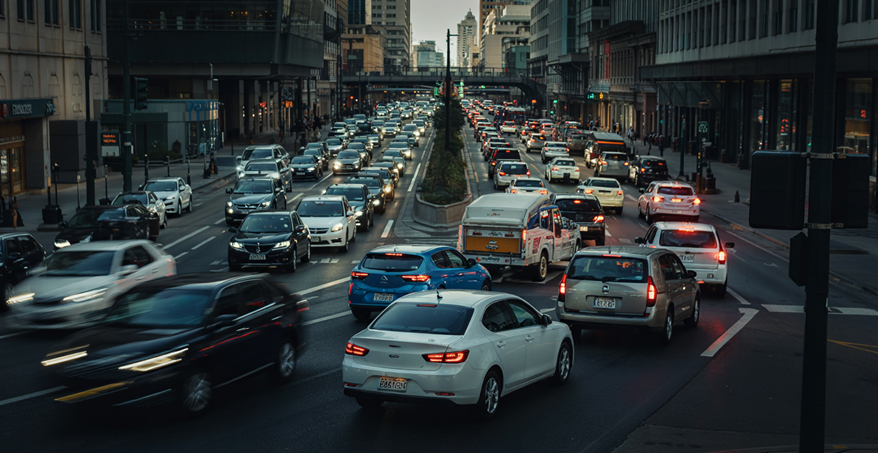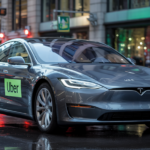Master city gridlock with expert strategies for safer, smoother driving in 2025.
Navigating congested urban roads isn’t just a test of patience—it’s a challenge that requires skill, awareness, and strategy.
As American cities grow and car ownership remains high, heavy traffic is an everyday reality for millions of drivers. From morning rush hour to weekend event snarls, the risks multiply in slow-moving, high-density environments.
In 2025, with more vehicles on the road than ever, safe driving in traffic isn’t optional—it’s essential. This guide breaks down practical, actionable strategies to help you stay alert, avoid accidents, and protect your vehicle (and your sanity) during daily commutes or long-haul city driving.
Know the Conditions Before You Go
Advanced planning is your first line of defense against traffic chaos. Leverage up-to-date tools like Google Maps, Waze, or Inrix Traffic to check congestion zones, accidents, and alternate routes. In 2025, real-time traffic forecasting powered by AI is integrated into most infotainment systems, including those in the Hyundai Tucson Hybrid ($32,000–$38,500) and Ford Escape Plug-In Hybrid ($40,500–$45,000).
Many modern vehicles now include predictive traffic assistance, which automatically adjusts your suggested route based on evolving congestion patterns. Learn how to activate these features in your car’s settings—it’s a safety tool, not just a convenience.
Maintain Proper Distance—Even in Stop-and-Go Conditions
Tailgating is one of the leading causes of low-speed collisions. In heavy traffic, always keep a safe following distance, even if it means losing a few feet to the car in front. The 3-second rule still applies at slower speeds but increases your reaction time substantially.
If you’re driving a newer model like the Toyota Prius Prime 2025 ($33,500–$39,000) or the Subaru Outback ($30,000–$42,000), activate adaptive cruise control. These systems automatically adjust your speed to maintain a safe gap, making them ideal for congested driving.
Avoid Lane Hopping
Switching lanes frequently in bumper-to-bumper traffic often increases stress without saving time—and it raises your risk of side-swipe accidents. Studies from the National Highway Traffic Safety Administration (NHTSA) confirm that most multi-lane maneuvers in gridlock situations have minimal time-saving benefits.
Instead, choose the most appropriate lane based on your exit or destination and stay put unless necessary. Many 2025 models like the Kia Sportage Hybrid ($29,500–$35,000) offer lane-keeping assist to help prevent drifting during long periods of low-speed travel.
Use Technology, Not Just Instinct
Modern cars are equipped with more driver-assist tools than ever. If you’re spending a lot of time in urban congestion, prioritize vehicles that include:
-
360-degree cameras or surround-view systems for tight parking and narrow squeezes (found in models like the Nissan Rogue Platinum, $39,500–$42,000)
-
Blind spot detection, crucial when navigating between buses, bikes, and aggressive drivers
-
Automatic emergency braking, especially helpful in multi-stop scenarios
For 2025, brands like Volvo, Honda, and Mazda have enhanced their semi-autonomous driving features for improved low-speed traffic handling.
Stay Calm and Stay Off Your Phone
Distraction in dense traffic is just as dangerous as at highway speeds. In fact, the AAA Foundation for Traffic Safety reports that more than 25% of urban fender benders in 2024 were linked to mobile phone use—even at speeds under 10 mph.
Use voice commands or hands-free controls for calls or navigation. Many vehicles now include Driver Attention Monitoring (like in the Genesis GV70, $46,500–$56,000) that alerts you if you show signs of fatigue or distraction behind the wheel.
Watch for Pedestrians and Cyclists
Urban environments are increasingly shared with bikes, e-scooters, and jaywalking pedestrians. In 2025, bike lane infrastructure has expanded dramatically across cities like New York, San Francisco, and Chicago. Stay vigilant at intersections and crosswalks—especially where visibility is blocked by buses or delivery vans.
If your vehicle includes rear cross-traffic alert or pedestrian detection, make sure it’s activated. These systems can reduce reaction time by up to 40%, according to data from the Insurance Institute for Highway Safety (IIHS).
Prepare Your Car for the Urban Battlefield
In high-density areas, vehicle wear and tear accelerates. Make sure your tires are properly inflated, your brakes are responsive, and your oil changes are current. A well-maintained car performs better under stress and gives you more control in stop-and-go conditions.
For drivers frequently in traffic, hybrid and EV options often handle heat and idling more efficiently. Consider vehicles like the Honda CR-V Hybrid ($34,000–$39,500) or the Chevrolet Equinox EV ($34,995–$44,000) for long-term fuel savings and smoother driving in congested zones.
Stay Patient, Stay Professional
Whether you’re commuting, driving for Uber, or running errands, congested driving tests your temperament. Aggressive maneuvers, excessive honking, and frequent braking don’t get you there faster—they just increase your risk and raise your blood pressure.
Professional drivers recommend maintaining situational awareness, breathing techniques, and even calming playlists to reduce stress. Some carmakers like Lexus now include calm mode settings in their infotainment systems, adjusting cabin lighting and audio to help drivers manage long periods of traffic exposure.
Heavy traffic isn’t going away. But with the right approach, the right technology, and the right vehicle, navigating it can become a safer, more controlled experience.
Safe city driving in 2025 is no longer just about knowing how to handle the car—it’s about knowing how to handle the environment.



Very good https://is.gd/tpjNyL
Awesome https://shorturl.at/2breu